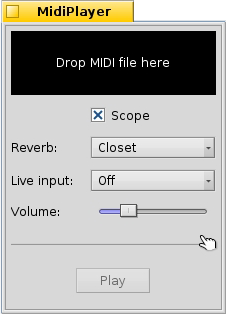 MidiPlayer
MidiPlayer
| Deskbar: | ||
| Localização: | /boot/system/apps/MidiPlayer | |
| Definições: | ~/config/settings/MidiPlayerSettings |
As the name suggests, MidiPlayer is used to playback midi music files. Midi files are special, as they don't contain the actual digitized and in some way encoded music, but only a description of it: Hold this note for that long with this volume and use instrument X for it.
While this keeps file sizes pretty small, it also follows that depending on the instrument library (the so-called "SoundFont") the results can differ hugely. Also, these SoundFonts tend to be quite large, increasingly so with the number and quality of the instrument samples.
Haiku doesn't come with a SoundFont installed, because they are so large and only few people generally need one. Most of those who do, already have high quality or custom SoundFonts. To be able to at least hear something you can install a free one from an optional package. In Terminal, enter: installoptionalpackage TimGMSoundFont
To use any other SoundFont, create a link to it in /boot/system/data/synth and name it big_synth.sy.

MidiPlayer's interface is very simple. Just double-click or drag & drop a midi file and playback starts. You control the volume with the slider and add reverb effects from the pop-up menu. Activating the scope will show a visualization in form of an oscilloscope running at the top.
 Português
Português Français
Français Deutsch
Deutsch Italiano
Italiano Русский
Русский Español
Español Svenska
Svenska 日本語
日本語 Українська
Українська 中文 [中文]
中文 [中文] Suomi
Suomi Slovenčina
Slovenčina Magyar
Magyar Português (Brazil)
Português (Brazil) Català
Català English
English